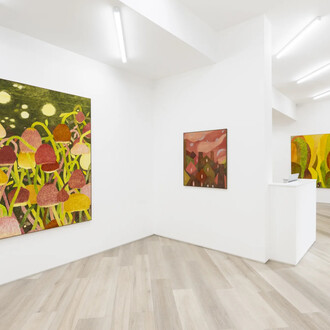Mapping the Abstract presents three artists who approach abstract painting with a remarkably fresh perspective. In an era where 'The Abstract' begets notions of technology and digital media, Benjamin Brett, Blake Daniels, and Robert Fry consider abstraction as a suggestive, organic, and gestural process – proving that perhaps painting, one of the most conventional of disciplines, ultimately reigns even today as one of the most experimental and exhilarating of all media.
Upon first instance the works appear to be departures from a school of figuration, however, while this may provide a type of intial segue between the three artists, one is able to notice that the deepest correlation (or even more markedly, the strongest difference,) lies in each artists relationship to space: precisely how paint maps the confines of a notion of space as transcribed within the two-dimensionality of the canvas. In this pursuit we can begin to see how their understanding of abstraction becomes an exploration of something more complex than geometry or disjointed, suggestive figuration. But any reliance on figuration or narrative that seems to unfold between the three appears to announce itself with the same urgency as its complete negation and affirmation of the absolute lack of narrative. Each seems to verify and validate his own context by its own existence; these are painterly constructions that operate like the Ouroboros – a symbol from Ancient Egypt of a snake which consumes its own tail, suggesting a self-fulfilling prophecy, one which Jungian psychology later appropriated to suggest the realm of possibility of the human psyche. Somehow, this carnal, metaphorical beast seems strangely appropriate as a metaphor for the psychological worlds mapped by each of the artists here.
While the beings in Daniels’ works come across as the most overtly humanoid, his paintings are concerned with what is happening on a much more complex scale: here he acts as the narrator of his own surroundings and diegesis. His paintings depict bodies and spaces that are altered, dislocated, and fragmented through the internalization of the socially built spaces that he has himself created. But is narrative of any importance here at all? Certainly linear narrative takes a secondary role to the complex relationship that occurs between the role of paint upon a support. The paintings become imbued by their textural quality, their daring and off-kilter compositions, the abundance of oblong shapes that might suggest limbs, tongues, plants, animals, or viscera, or conversely, that may exist within the confines of the painting just because. A combative shift of the body’s relation to space used to create identities non-contingent on linear narratives.
Similarly, Myriam Blundell writes that Robert Fry’s “enduring preoccupation is to find a visual equivalent to the metaphysical space separating the act of representation from the language of abstraction”. While the suggestion of the figure is central to Fry’s practice, it is the relationship between the being, the surrounding, and the paint itself wherein which Fry finds his locus. The atypical color-choices and painterly immediacy further affirm Fry’s statement, the (ungendered, but historically linked to royalty and piety) deep purple at use here becomes almost Fry’s trademark hue upon which shadows, anatomical extensions, and dismembered body parts refer to a deepening of psychological states, not unlike Rorschach inkblots. But something about his color choices becomes carnal - we see references to Bacon, Guston, Twombly, (and, in Man with Vesalius Skeleton, even Dutch anatomist Andreas Vesalius) but the languages and landscapes emerge as undoubtedly Fry’s own creation.
The works that enunciate the least of the three, Benjamin Brett, takes an almost playful approach to the concept of space, where context prevails and Brett exhibits a cognizance for the construction of the ‘background’; yet we are scarce to see any regimented approaches here, apart from the occasional rhombus-motif foundation lain beneath which his painterly gesture takes shape. The contextual emerging gestures and references are buoyant, suggestive, barely figurative, yet the mind connects these painterly marks into a kind of mental connect-the-dots, where narratives emerge. But it cannot be precisely said whether Brett’s intentions are to have the viewer construct narrative, or we are simply hard-wired to consider symbols in this semiological manner. In any regard, Brett has created a subtle tapestry for our consideration, wherein confident but marginally-obscure colour choices and sublimated; nearly cartoonish figurative articulations trace the stream-of-consciousness markings of the maker; and palimpsestial colours beneath layers of thin paint suggest paintings beneath paintings - a process of definition and re-definition: marking and mapping the abstract.
















